Chapter 55 Ap Biology Reading Guide Answers
Are you lot planning on taking the AP® Biological science test? If so, let's become you prepared in this AP® Biology review past learning more virtually the exam and how to study so that yous tin can feel confident and earn your best score and potentially college credit.
The AP® Biology examination is graded on a scale of 1-v, and yous can earn higher credits at many colleges for receiving a score as low as a 3, which is estimated to exist approximately equivalent to earning a C, C+, or B- in a higher-level biology course. However, there is quite a bit of variation between colleges in what test scores they will award credit for, if any, so be sure to check with the specific colleges in which you are interested to see what score(south) they take.
In this AP® Biology review mail service, nosotros'll go over cardinal questions yous may have near the exam, how to study for AP® Biology, and how to review and utilise AP® Biological science exam practice resources, including AP® Biology practice tests, equally you begin preparing for your exam.
Are you ready? Allow's become started.

What's the Format of the 2022 AP® Biological science Exam?
The AP® Biological science exam is equanimous of two sections: multiple choice and gratis response. At that place are sixty multiple pick questions and half dozen free-response questions (2 long-answer questions and 4 short-answer questions).
| Section | # of Questions | Fourth dimension Limit | % of Overall Score |
| I: Multiple Choice | lx | 90 minutes | 50% |
| II: Gratis Response | half dozen | xc minutes | 50% |
For the 2022 examination season, the AP® Biological science test is being offered in merely newspaper-and-pencil format (in previous years, the test was offered digitally as a result of COVID-19).
How Long is the AP® Biology Exam?
The AP® Biology exam is a 3 hour exam. Students will have xc minutes to complete 60 multiple option questions and another 90 minutes to complete 6 gratuitous-response questions.
How Many Questions Does AP® Biological science Have?
The AP® Biology exam has 60 multiple choice questions and half dozen free-response questions. Of the half dozen gratuitous-response questions, iv are short-reply questions while the other ii are long-answer questions.
What Topics are Covered on AP® Biology?
There are ii types of questions on the AP® Biology test: multiple choice and free response.
Section I: Multiple Option
The AP® Biology exam multiple choice section assesses both content knowledge and scientific discipline practices , with questions designed to do both. These multiple option questions may be either private or in sets of iv to 5 questions per set.
The content cognition within the 8 different form units is broken down into iv large ideas , with learning objectives related to each:
- Evolution (EVO)
- Energetics (ENE)
- information Storage and Manual (IST)
- Systems Interactions (SYI)
Questions within each content expanse, with the relevant learning objectives addressed, are weighted in the multiple choice section as shown; resources for written report, AP® Biological science review, and AP® Biological science exam practice for each section are also provided. You tin can use this to make an AP® Biology study guide.
| Units, Topics, and Learning Objectives | Weighting on Exam | Resource |
Unit 1: Chemical science of Life
| viii-11% | The Chemical Foundation of Life
Biological Macromolecules
Albert Practice Questions: Unit of measurement 1 |
Unit 2: Cell Structure and Function
| 10-13% | Cell Structure
Structure and Function of Plasma Membranes
Albert Practice Questions: Unit 2 |
Unit 3: Cellular Energetics
| 12-xvi% | Metabolism
Cellular Respiration
Photosynthesis
Albert Do Questions: Unit 3 |
Unit 4: Cell Communication and Cell Cycle
| ten-15% | Cell Communication
Cell Reproduction
Albert Practice Questions: Unit 4 |
Unit 5: Heredity
| eight-11% | Meiosis and Sexual Reproduction
Mendel'south Experiments and Heredity
Modernistic Understandings of Inheritance
Albert Exercise Questions: Unit 5 |
Unit six: Gene Expression and Regulation
| 12-xvi% | Dna Construction and Role
Genes and Proteins
Gene Regulation
Biotechnology and Genomics
Albert Practice Questions: Unit 6 |
Unit 7: Natural Selection
| 13-20% | Evolution and Origin of Species
The Development of Populations
Phylogenies and the History of Life
Albert Do Questions: Unit 7 |
Unit 8: Ecology
| x-15% | Environmental and the Biosphere
Population and Customs Environmental
Ecosystems
Conservation Biological science and Biodiversity
Albert Practice Questions: Unit eight |
Source: College Board
Return to the Table of Contents
While there are no units specifically devoted to prokaryotes and viruses, having a basic agreement of prokaryotic and virus structure, evolution, environmental, and diversity will be helpful since prokaryotic and eukaryotic mechanisms are compared in various units. Thus, we recommend that yous review this information besides.
The six unlike science practices are divided into skills and are besides assessed in the multiple pick section and weighted as shown:
| Science Exercise and Skills (A, B, C, etc.) | Weighting on Exam |
one. Concept Caption: Explain biological concepts, processes, and models presented in written format.
| 25-33% |
2. Visual Representations: Analyze visual representations of biological concepts and processes.
| sixteen-24% |
3. Questions and Methods: Determine scientific questions and methods.
| eight-14% |
4. Representing and Describing Information: Represent and describe data.
| 8-xiv% |
5. Statistical Tests and Data Assay: Perform statistical tests and mathematical calculations to analyze and interpret data.
| 8-14% |
6. Argumentation: Develop and justify scientific arguments using evidence.
| xx-26% |
Source: College Lath
You can too get AP® Biology examination practice in both the scientific discipline practise and content knowledge by completing the Albert practice questions associated with each of 13 lab activities.
Return to the Table of Contents
Department Ii: Gratis Response
The AP® Biology free response questions are also designed to assess both content knowledge and science practices and are organized effectually the science practices and the four big ideas for the grade.
The free response questions are designed as follows, with each of the brusque-answer questions also assessing one of the four big ideas:
| Free Response Question | Point Breakup and Total |
| #i: Long-Answer: Interpreting and Evaluating Experimental Results: gives an authentic scenario with information table or graph |
|
| #2: Long-Respond: Interpreting and Evaluating Experimental Results with Graphing: gives an authentic scenario with data table |
|
| #3: Brusque-Answer: Scientific Investigation: describes a lab investigation scenario |
|
| #4: Short-Answer: Conceptual Analysis: gives an authentic scenario describing biological phenomenon with a disruption |
|
| #five: Short-Reply: Analyze Model or Visual Representation: requite an authentic scenario with visual model or representation |
|
| #6: Brusque-Respond: Analyze Data: gives information in a graph, table, or other visual representation |
|
Source: College Board
You lot volition be provided an AP® Biology Equations and Formulas Sheet that you may utilize on either department of the exam. You are likewise permitted to employ a iv-function, scientific, or graphing estimator throughout the examination.
Render to the Table of Contents
What Do AP® Biological science Questions Await Similar?
Considering taking an test is a skill, completing AP® Biology examination exercise questions, then reviewing the answers carefully, is a great style to prepare for the AP® Biology exam and so that yous are not caught off guard by whatsoever content or question formats. The AP® Biological science Grade and Exam Description (CED) for AP® Biology from the College Lath provides xv multiple choice practice questions and correct answers that address content noesis from all eight units besides as skills from all vi science practices.
The CED for AP® Biology also provides 2 practice free response questions (one long-respond question and one short-answer question) with detailed grading rubrics. The College Lath has also released the free-response questions with scoring guidelines from the last twenty years' worth of exams through 2019. The College Board has likewise released a complete practice exam with answers based upon the 2013 examination . Albert also provides a wide multifariousness of both AP® Biological science test practice multiple choice and costless-response questions and answers, as well every bit unit assessments and complete AP® Biology practice tests .
Multiple Choice Examples
Here are some examples of the types of multiple selection questions you may see, likewise as the right answer, unit of measurement(due south), and science practice(southward) that each question (or question set) assesses.
Case #1:
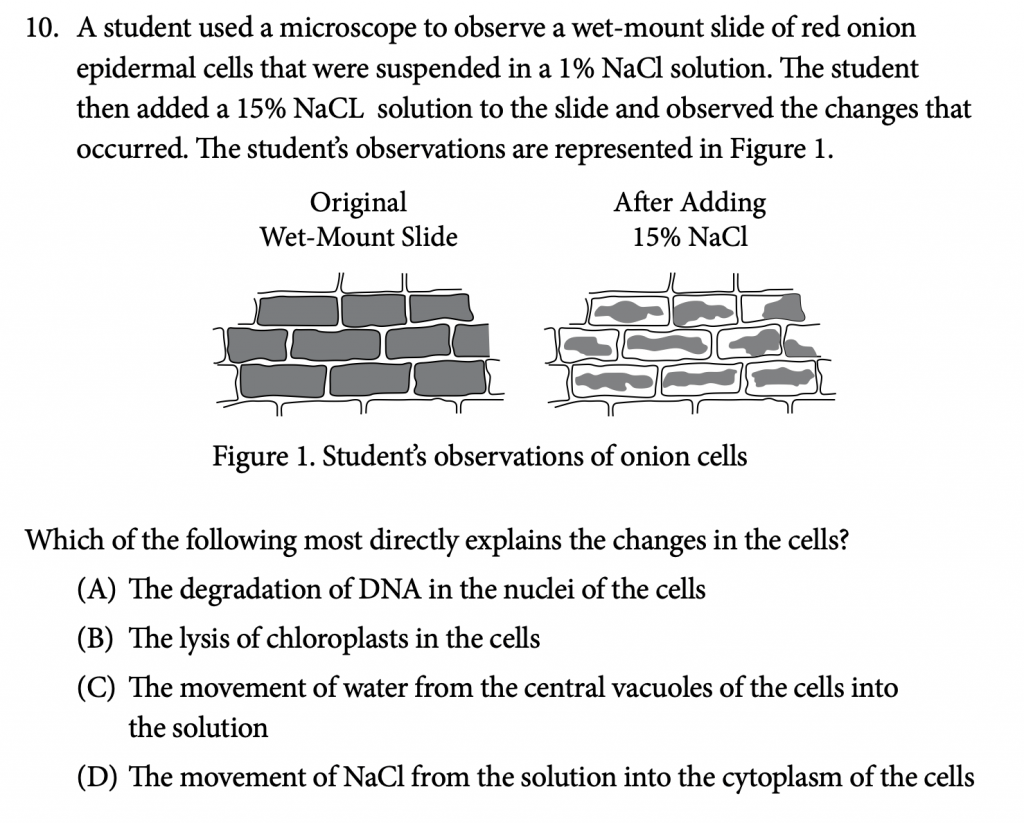
AP® Biology Course and Exam Description (CED) – MC Example #10
Right Answer: C
This question challenges students on i core principle and ane science practice.
For Unit 2 (Cell Structure and Function), y'all should flag the topic of tonicity and osmoregulation equally of import.
For Science Practice ii (Visual Representations), you should flag the following every bit important:
- Explain relationships between different characteristics of biological concepts, processes, or models represented visually in applied contexts.
Example #ii:
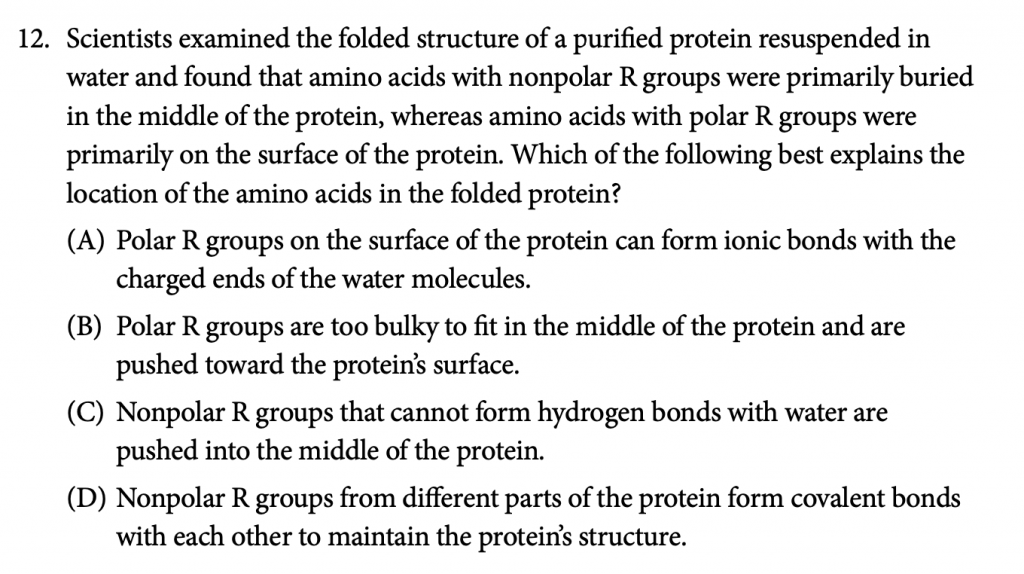
AP® Biology Form and Exam Description (CED) – MC Example #12
Right Answer: C
This question challenges students on one cadre principle and ane science practise.
For Unit i (Chemistry of Life), you should flag the topic of properties of biological macromolecules as important.
For Science Practice 1 (Concept Explanation), you should flag the following as important:
- Explain biological concepts and/or processes.
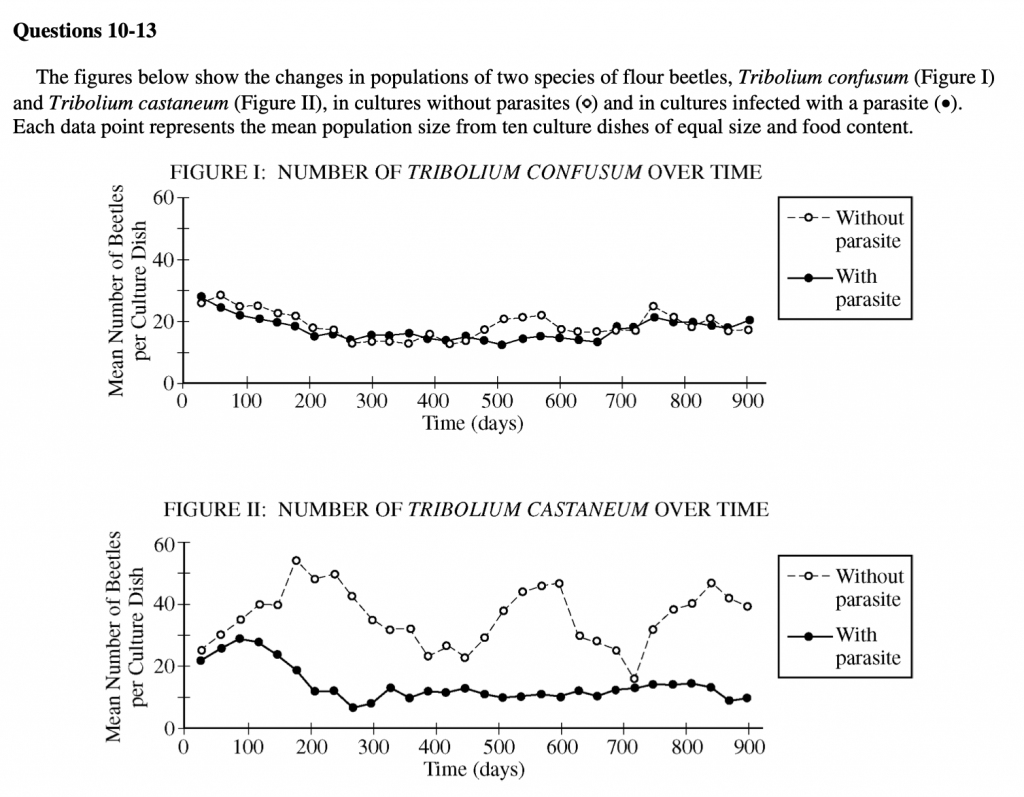
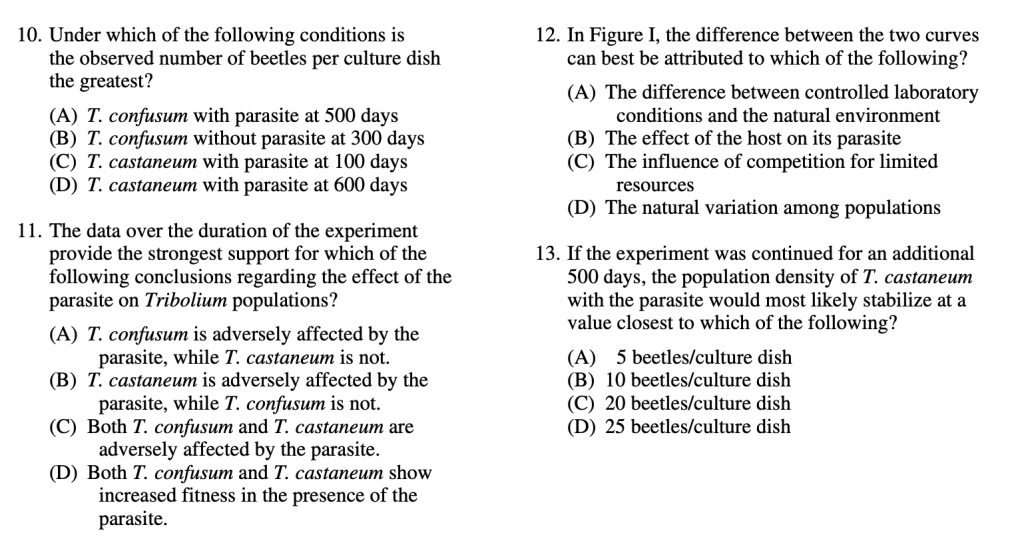
AP® Biology Practise Test from the 2013 Administration – MC Examples #10-13
Examples #three-6
Right Answer #10: C
Correct Answer #xi: B
Correct Answer #12: D
Right Answer #13: B
These questions claiming students on one core principle and two scientific discipline practices.
For Unit 8 (Environmental), you should flag the topic of population environmental equally important.
For Scientific discipline Do two (Visual Representations), y'all should flag the following as important:
- Explicate relationships between different characteristics of biological concepts, processes, or models represented visually in applied contexts.
For Science Practice 6 (Argumentation), you should flag the following as of import:
- Support a claim with testify from biological principles, concepts, processes, and/or data.
- Provide reasoning to justify a claim by connecting prove to biological theories.
- Predict the causes or effects of a change in, or disruption to, one or more than components in a biological system based on data.
Return to the Tabular array of Contents
Free-Response Examples
Annotation that the specific focus of each free-response question is more targeted than in years past.
When writing answers to free response questions, exist sure to write your answers in the designated space only and in complete paragraphs. Bulleted lists, outlines, and diagrams without caption are not acceptable and volition not be graded. Also exist sure that yous well empathize the various task verbs used, as explained in the AP® Biological science Course and Exam Clarification (CED) .
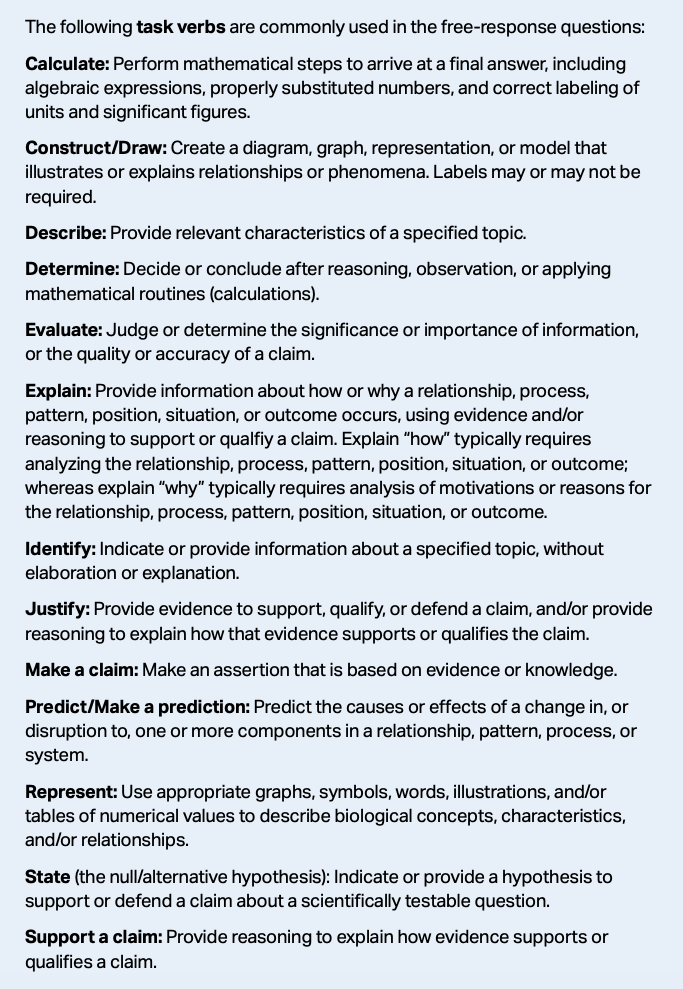
Here are ii examples of the types of complimentary response questions you may encounter, as well equally the correct reply, scoring rubric, and commentary for each question. The unit(s), and science exercise(s) that each question assesses is also provided. I long-answer question and one brusk-reply question are shown.
Example #one: AP® Biological science Long-Reply Free-Response:
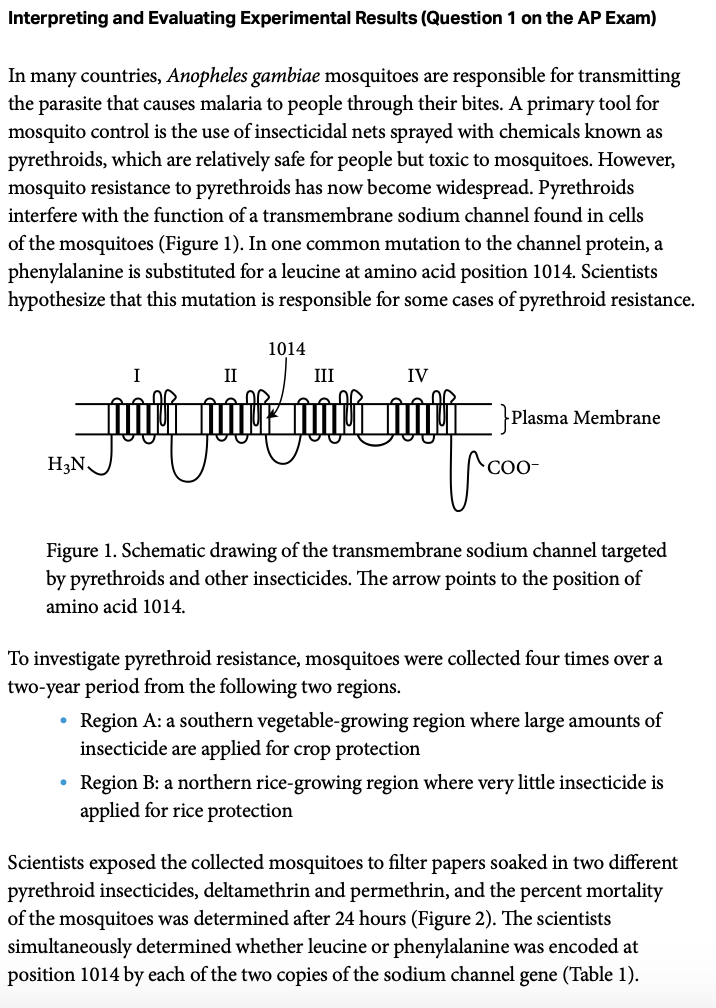
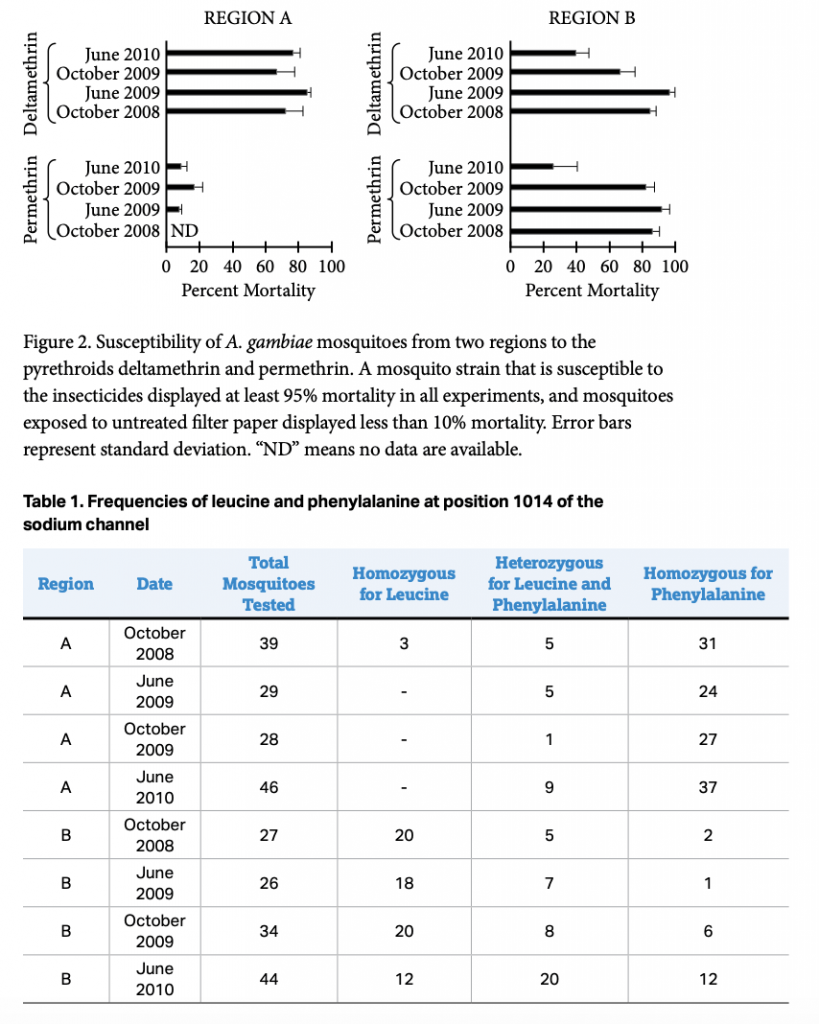
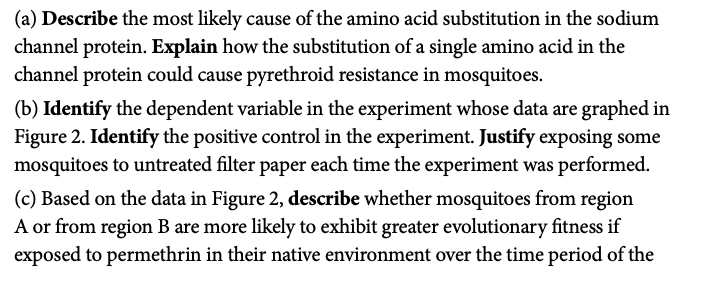
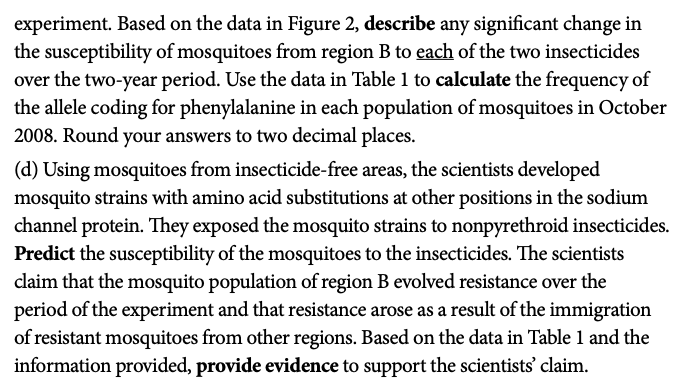
Carefully review the scoring rubric provided for this question.
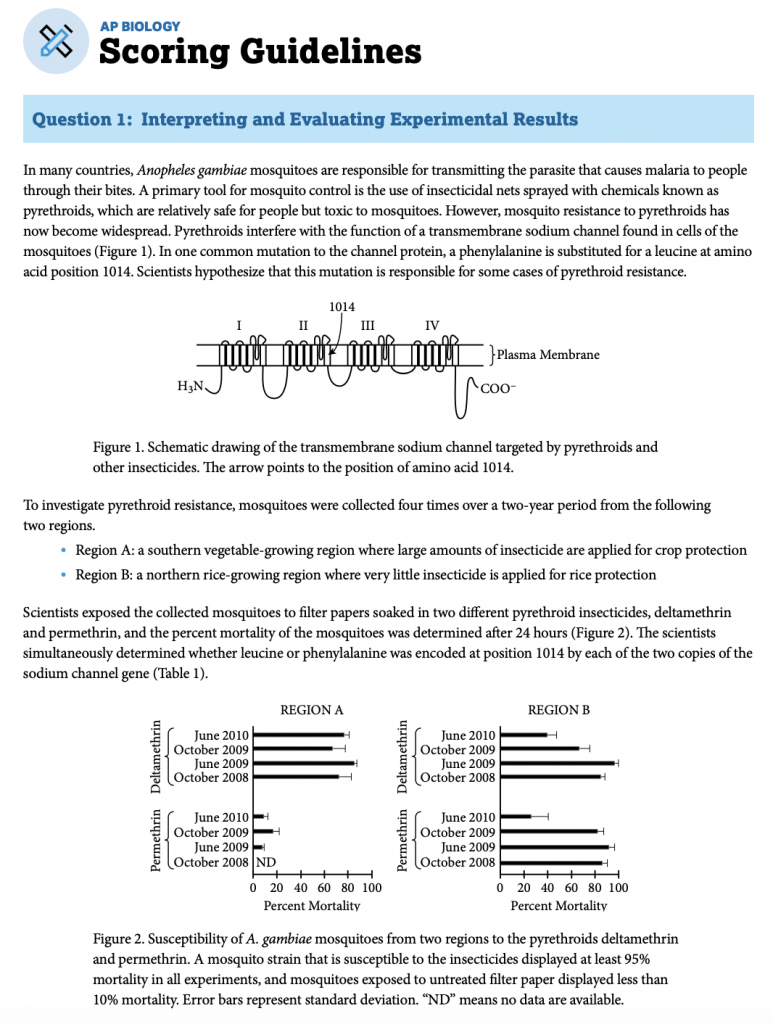
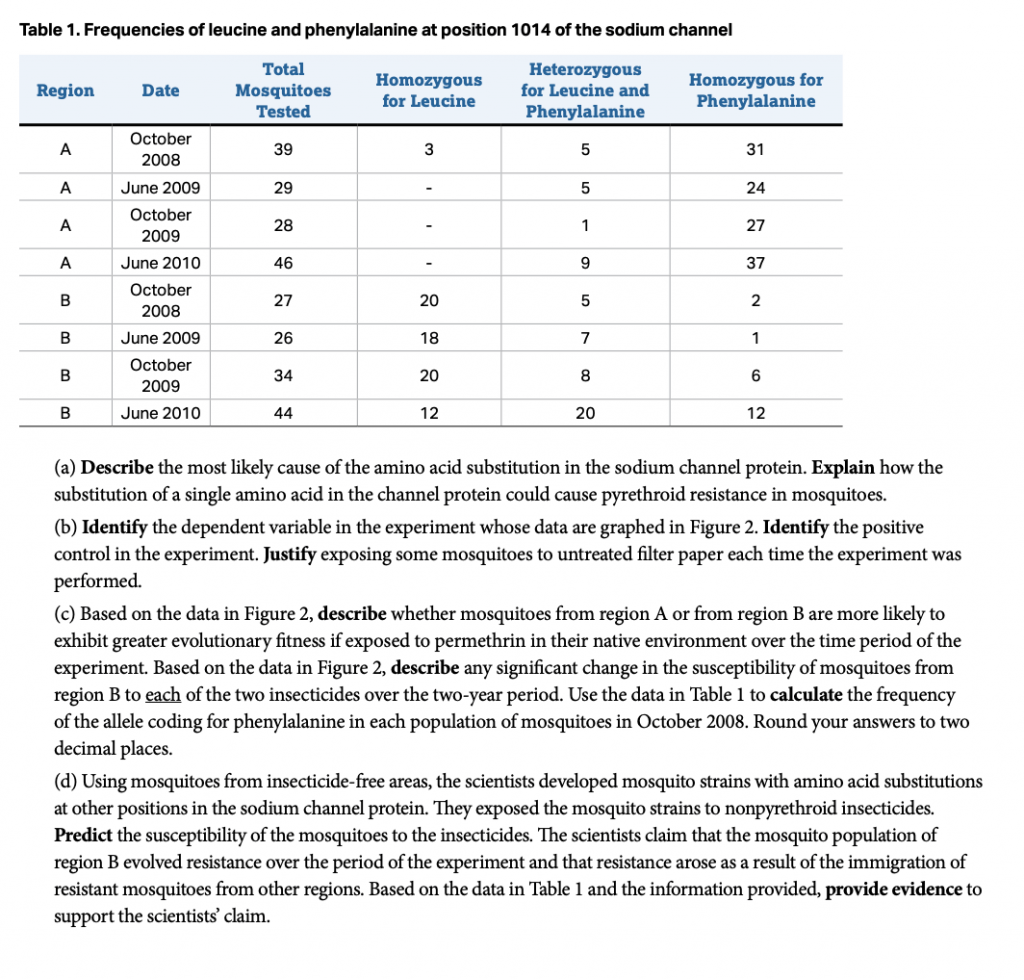
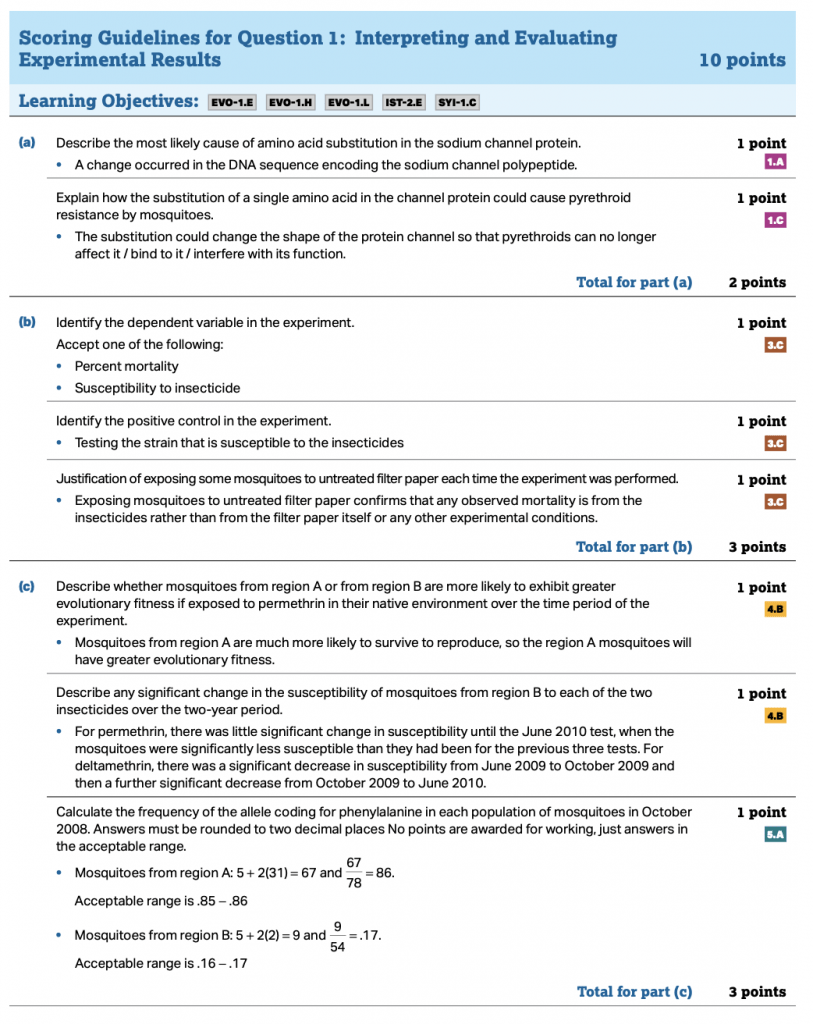
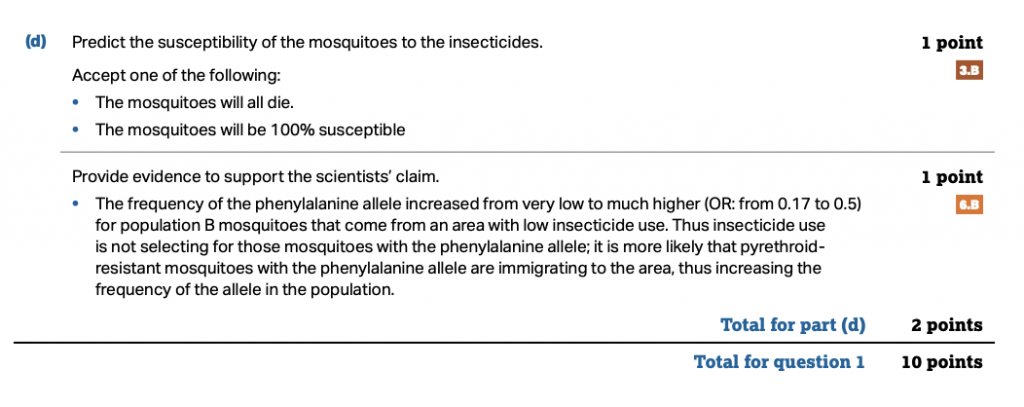
This question challenges students on three core principles: Natural Selection (Unit of measurement seven), Factor Expression and Regulation (Unit half dozen), and the Chemical science of Life (Unit ane).
Here's the content that you should flag as of import from this question:
- Unit 7: Natural Selection, Population Genetics, and Hardy-Weinberg Equilibrium
- Unit half dozen: Mutations
- Unit of measurement one: Structure and Function of Macromolecules
This question besides covers four of the science practices: Concept Explanation (Science Do ane), Questions and Methods (Scientific discipline Practice 3), Representing and Describing Information (Science Practice iv), Statistical Tests and Data Analysis (Science Practice five).
Here'south the scientific discipline practices that yous should flag as important from this question:
Science Practice 1: Concept Caption:
- Describe biological concepts and/or processes.
- Explicate biological concepts, processes, and/or models in applied contexts.
Science Practice iii: Questions and Methods:
- State the null or alternative hypotheses, or predict the results of an experiment.
- Identify experimental procedures that are aligned to the question
Scientific discipline Practice 4: Representing and Describing Data:
- Depict information from a table or graph.
- Science Practice 5: Statistical Tests and Data Analysis: Perform mathematical calculations.
- Science Practice 6: Argumentation: Support a claim with evidence from biological principles, concepts, processes, and/or data.
Return to the Table of Contents
Example #ii: AP® Biology Short-Answer Free-Response:
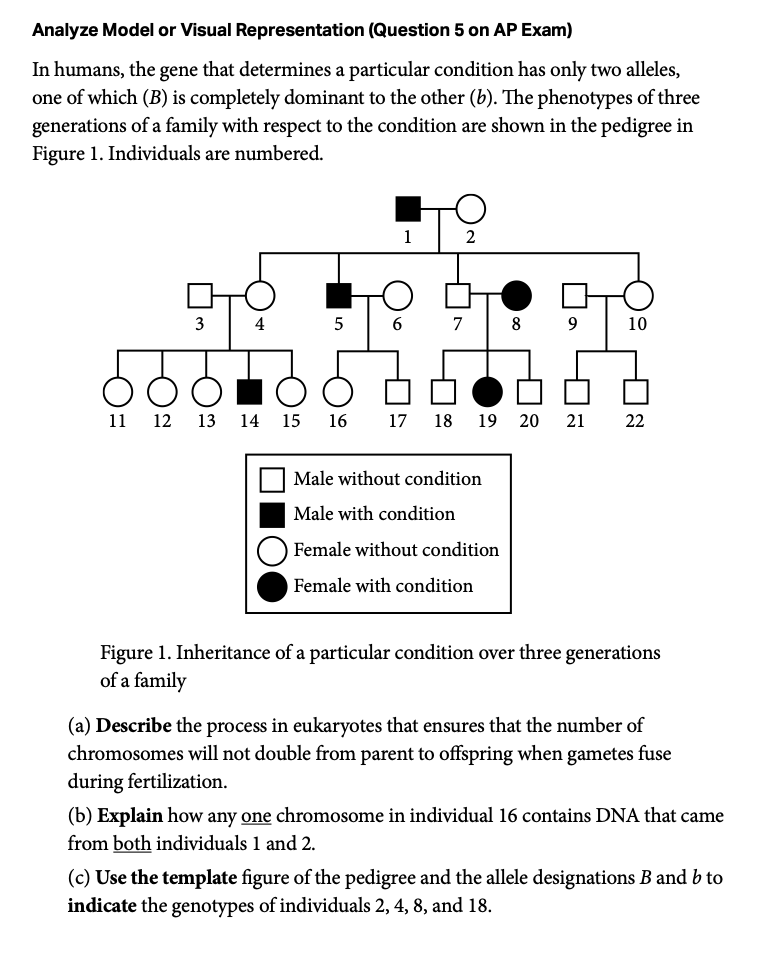
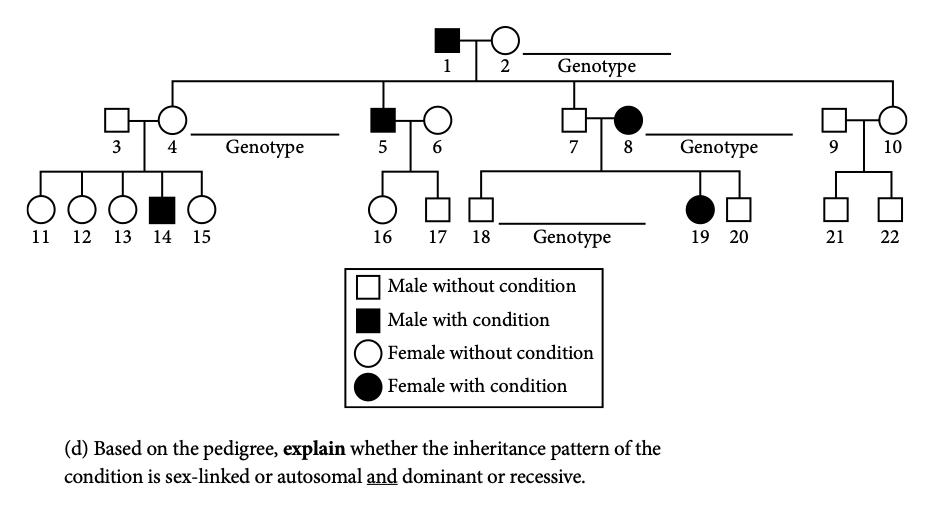
Carefully review the scoring rubric provided for this question.
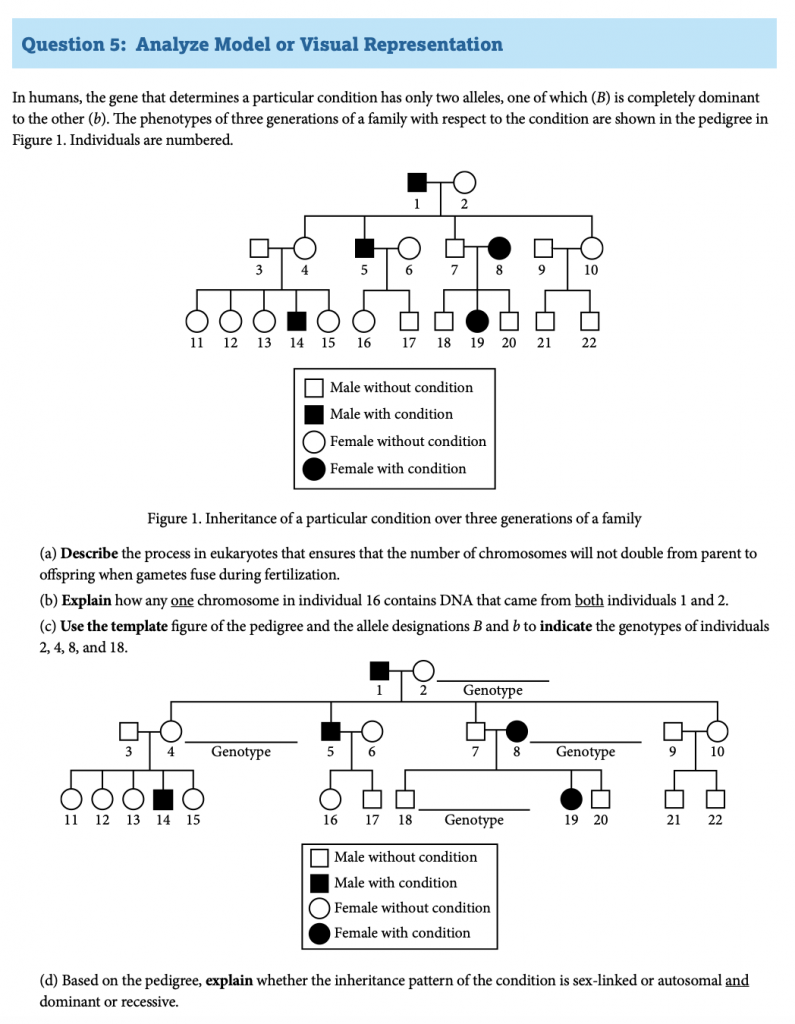
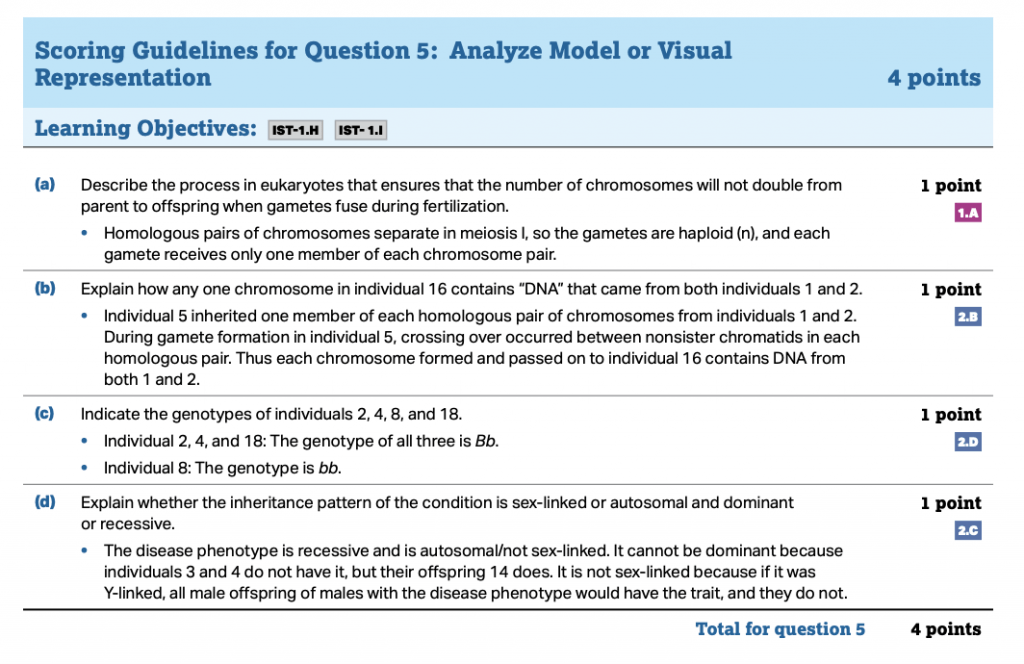
This question challenges students on one core principle, Heredity (Unit 5).
Here's the content that you should flag as important from this question:
- Unit 5: Meiosis and Genetic Diversity, Mendelian Genetics
Here'southward the science practices that you should flag equally important from this question:
- Science Practice ane: Concept Explanation: Describe biological concepts and/or processes.
- Science Practice two: Visual Representations:Explain relationships betwixt unlike characteristics of biological concepts, processes, or models represented visually
Render to the Table of Contents
What Tin You Bring to the AP® Biological science Exam?
Make certain yous get in at least fifteen minutes early on to your testing location.
The College Board is rather specific about what you tin can and cannot bring to the AP® Biology test. You are at take chances of having your score non count if you do not carefully follow instructions. We recommend that you carefully review these guidelines and pack your bag the dark before and then that yous do not have any additional stress on the forenoon of the test.
What You Should Bring to Your AP® Biology Examination:
You should bring:
- At least 2 sharpened No. 2 pencils for completing the multiple choice section.
- At to the lowest degree 2 pens with black or blue ink only. These are used to complete certain areas of your exam booklet covers and to write your free-response questions. The College Board is very specific that pens should be black or blueish ink but, then please double-check!
- A four-function, scientific, or graphing calculator to utilize on both the multiple pick and free-response sections of the exam. You may actually bring two calculators. Calculators cannot connect to the internet, brand noise, or have a stylus or keyboard. For more data near acceptable versus unacceptable calculators, wait here .
- If you exercise non attend the schoolhouse where y'all are taking an exam, you lot must bring a government issued or school issued photo ID.
- If you receive any testing accommodations , be certain that y'all bring your Higher Board SSD Accommodations Letter.

What Y'all Should Not Bring to Your AP® Biology Exam:
You should non bring:
- Electronic devices of any kind, as listed below, across the permitted calculators are prohibited in both the exam room and break areas:
- phones
- smartwatches and other clothing engineering (including watches that beep or have alarms)
- tablets
- cameras
- laptops
- carve up timers
- devices that access the net or communicate in whatever way
- Mechanical pencils, colored pencils, or pens that do not have black/blueish ink
- Your own scratch newspaper
- Reference guides (note that you will be provided with an AP® Biology Equations and Formulas Sail )
- Nutrient or drink, including bottled water, are not permitted in the test room, but are permitted in the interruption room
Render to the Table of Contents
How to Study for AP® Biology: 5 Steps to Get a five

1. Take an AP® Biology practice test. (three hours)
Identify your areas of force as well as focus areas for review by taking an Albert AP® Biology practice examination . Exist certain to have a 4-function, scientific, or graphing estimator to use.
two. Make a schedule. (1 hr)
Decide your examination appointment and format. And so, offset preparing early on, giving yourself at least two months if possible. Later on taking an Albert AP® Biology do test to identify areas for report, make a schedule, giving yourself at to the lowest degree a calendar week for each content unit on your AP® Biology study guide.
- While you should prioritize cloth where you struggle, spending at least a calendar week on each unit, also review those units you know better for at to the lowest degree 2-3 days each to stay sharp then that you can answer these questions apace.
- If you are running curt on study time, prioritize Units iii, 6, and seven since these are the most heavily weighted on the exam, and spend less time reviewing Units i and five since these will exist covered the least.
3. Review challenging concepts using your resources and build your AP® Biology study guide. (2-5 hours)
Use your high school textbook and notes and other accessible materials (like OpenStax Biology , Khan Academy , or CK-12 ) for AP® Biological science review of the various content areas. As you review each chapter, build your AP® Biological science study guide, the outline of which has already been provided in a higher place, to include of import cardinal words and concepts for each unit of measurement.

4. Utilize AP® Biology exam practice resources. (20-25 hours)
The all-time style to become constructive at test-taking is by answering lots and lots of AP® Biology exam exercise questions because practice makes perfect!
Use the AP® Biological science exam practice questions provided by the College Lath, the Albert AP® Biology examination practise questions for each unit, as well as unit assessments to back up your study.
v. Get more AP® Biology examination practise. (3 hours)
After completing steps 1-4, take another Albert AP® Biology practice test to identify content areas that require more review.
Return to the Tabular array of Contents
AP® Biological science Review: xv Must Know Study Tips
5 AP® Biology Report Tips to Do at Home:
ane. Be consistent.
Devote time to studying and preparing daily. Even if it is only a few minutes on some days when you are busy, exist sure to study each and every day.
2. Use an app like Quizlet for studying cardinal terms.
There are already a bunch flashcards and report guides preloaded into Quizlet (vocab lists from your textbook may already exist available), or you lot can easily make your own. Then, you can exist reviewing key terms and studying whenever y'all have a few gratuitous moments (similar continuing in line at the store, riding the bus, etc.). If this doesn't work for y'all, you tin still make flashcards the sometime-fashioned manner using alphabetize cards.
three. Remove distractions.
It is easy to go distracted during studying past texting, SnapChats, due east-mailing, listening to music, etc. Unfortunately, multitasking is ineffective; information technology takes about 25 minutes to return to a task after a distraction. Therefore, you can be much more time efficient and productive if yous study distraction-gratis.

4. Study with a buddy.
It can be helpful to run into and study with a friend periodically. It tin can exist helpful to talk out concepts from your AP® Biology study guide with each other because they might describe it differently and in a way that yous more easily understand. Additionally, having regular appointments to do so can help to hold you answerable to go through your study plan at a regular stride and not slack off. However, while y'all tin besides schedule in time for fun and hanging out later on your report appointments, brand certain that your planned study time is focused on actual studying.
5. Learn how to use your calculator.
Call back that yous cannot use your phone equally a calculator on the AP® Biology test. Therefore, make sure that you take a calculator that meets the requirements and that y'all know how to employ it. Exercise using it as you consummate AP® Biology test practice questions and AP® Biological science practice tests. The first time you use it should NOT exist during the AP® Biological science exam.
v AP® Biology Multiple Choice Study Tips:
1. Stride yourself.
You will accept ninety minutes to complete sixty multiple choice questions on the AP® Biology test. Thus, you should spend no more than than 2 minutes on whatsoever one question during your first pass through the questions (this assumes that you will move more apace through other questions). If you lot get stuck, mark the question, eliminating any answer choices you can, and move on. And then, come back later afterward you accept completed all other questions. Make sure you fill in an reply for each question.
ii. Imagine the correct respond.
Later on carefully reading a question, come up up with a mental paradigm of an answer before examining the answer choices. Choose an respond that matches your mental image and then justify your selection. Then, justify why y'all eliminated each of the other choices. If you lot cannot choose an answer, eliminate equally many as possible, and so make your best choice. When using the Albert AP® Biology Do questions , carefully read the explanations of both the right and wrong choices, even if you got the answer correct.
iii. Carefully examine any visual materials provided.
Make certain you examine whatever labels, titles, axes, and legends on tables, graphs, figures, or any other types of images so that yous have a clear agreement of how to interpret the visual materials provided in social club to answer the questions associated with these materials.
4. Be ready to handle questions that are grouped as sets.
While many of the multiple choice questions are individual, you should look a few sets of 2-4 questions. Make certain you know which questions are included as a question set. Questions inside a set up are all typically associated with one or more figures or tables. While these questions are related, don't requite up if you don't know the answer to the starting time question. Each question can typically be answered independently of the others inside the ready.
5. Check your work.
If possible, plan to use at least 10-fifteen minutes of the exam time to bank check your piece of work. First, return to whatever questions that y'all found hard to compete on the first laissez passer, beingness sure to select an answer. Then, review your answers to all of the questions, ensuring that y'all accept answered each and every question.
5 AP® Biology Gratis Response Written report Tips:
1. Keep track of time.
You will take 90 minutes to complete the half-dozen free response questions on the AP® Biological science exam. Because each of the two long-answer questions are more extensive and together are worth over half of the gratis response section (x points each), you should programme to spend near 20 minutes on each. Then, spend no more than 10 infinitesimal on each of the 4 curt-respond questions (worth 4 points each). Use whatever remaining time to review your answers, making certain they are complete.

2. Make sure y'all understand the scoring rubrics.
The Higher Lath has provided a clear scoring rubric for each of the half-dozen free response questions (provided higher up, from the AP® Biological science Course and Exam Clarification (CED) ). Exist sure that you are writing your answers with these rubrics in mind, fully addressing each function. Additionally, within the AP® Biological science Course and Exam Description (CED) ), the College Lath has besides provided detailed scoring guidelines (also provided to a higher place) for both a long-answer question and short-answer question. Review these advisedly, making sure you understand what is required to earn each and every point. While the College Board has also provided the scoring guidelines for the many free response questions from by exams that they take made available for exercise, too every bit Chief Reader Reports from past exams that summarize both how students performed on a particular question and what the readers were looking for, remember that the focus of the free response questions on the 2021 AP® Biology exam is different than in years past, so these examples will be slightly unlike than what you lot will see when yous take the examination.
iii. Focus on the verbs.
For each question, focus on its verbs and other clarifying words. Underline or circle each bolded word as well as other fundamental words. Brand certain you understand what each task verb is asking yous to practise. Review the list of AP® task verbs provided above.
4. Write in complete sentences and paragraphs.
The directions for the costless response department clearly state that "outlines, bulleted lists, or diagrams alone are not acceptable and will not be scored". Thus, brand sure to write your answers in complete sentences and organize your thoughts into paragraphs, using the infinite provided for each question.
v. Ensure that you lot follow these five must-dos to respond each question completely:
- It is common for students to recapitulate the question equally they respond a gratuitous response question, but this is non necessary and is a waste product of precious time. Instead, focus on straight answering what the question is asking. Past Primary Reader Reports from the College Lath recommend careful reading and addressing of the prompt.
- The free-response questions are unremarkably broken into parts. Make sure that you reply each office. Additionally, make certain that y'all are actually answering what each question is asking.
- If a adding is required, exist certain to clearly mark your final respond, and show your work as to how you reached that respond.
- If asked to make a table or graph (at least i of the long-answer questions will require this), be sure to follow standard conventions: include a title, characterization columns or axes (including units), plot points. Depict a line or curve only through the information provided and do not extrapolate unless asked to practise then.
- Be succinct merely complete in your answers, completing each thought ("closing the loop"). You volition not earn points simply for quantity, but rather, for quality. The AP® graders will not know what y'all were thinking or what y'all meant; they only know what you wrote. DO NOT PROVIDE ONLY A SINGLE Judgement Answer to any question.
- When making an statement, use the structure of "merits-evidence-reasoning", making sure that you include each of these three components in your reply.
Render to the Table of Contents
AP® Biology: 5 Test Day Tips to Recollect
1. Go a good nighttime's sleep the night before.
Complete your intense studying by the afternoon the day before the examination, then have a expert dinner and get a skilful night's sleep (half-dozen-8 hours, if possible). Prepare your alarm, giving yourself plenty of fourth dimension for breakfast and for driving to the examination site.
ii. Pack your bag the dark before:
Review the items that you are and are not allowed to bring to the AP® Biological science exam and pack accordingly. Utilise Albert'south convenient checklist for packing. Include a snack and some water for the break room, but call back that these are not allowed in the testing room.

3. Replace the batteries in your calculator.
Because you don't want your calculator running out of juice during the exam, be sure to alter the batteries in your computer with a fresh fix within a day or so before the exam.
four. Eat a healthy breakfast.
Be certain to eat a healthy breakfast on the morning of the exam. Make certain that information technology includes both protein and carbs and is not all sugary foods. Too, try to avoid over-caffeinating–yous don't desire to exist jittery.
5. Make sure you lot are gratis of electronic gadgets.
In this day and age, we have get and so accustomed to having or wearing technology. Exist sure that you are technology-costless when walking into the exam room: no phones, earbuds, smart watches, bluetooth, etc.
Return to the Tabular array of Contents
AP® Biological science Review Notes and Practise Exam Resources
Here are our recommendations for resources to review for and fix for the AP® Biology exam: Your High School Biology Textbook, Notes, Homework Assignments, Exams, Laboratory Activities, and Other Resources Provided by Your Instructor.
If you are taking an AP® Biology class, your teacher has carefully designed the course to prepare you for the AP® Biology exam. Employ the many resource that your instructor has provided for AP® Biology review, carefully reviewing your notes, exams, homework assignments, etc.
AP® Biology Practice Materials Provided by the Higher Lath:
The College Lath has provided quite a lot in the fashion of exercise materials for the AP® Biology examination. Throughout this document, nosotros have mentioned the AP® Biology Course and Exam Description (CED) multiple times. Y'all should review this document advisedly. Note that at that place are xv multiple choice practice questions and correct answers that address content cognition from all eight units likewise as skills from all six science practices. This document also provides two do free response questions (1 long-answer question and one short-reply question) with detailed grading rubrics.
The College Board has also released the free-response questions with scoring guidelines from the xx years' worth of exams through 2019. The College Lath has besides released a consummate AP® Biology practice examination with answers based upon the 2013 exam . Notation, however, that the format of the costless-response department is irresolute slightly for the 2021 AP® Biology exam; while there used to be 8 questions (two long-answer questions and vi short-answer questions), the 2021 AP® Biology exam volition take only 4 short-answer questions. Additionally, each question is more focused on specific skills than in years past, as indicated past the detailed scoring rubrics.
OpenStax AP® Biology Textbook and Resource :
This is a groovy freely available textbook with associated resource designed specifically for preparing for the AP® Biological science test. At that place are additional resource available for students, including a student solutions manual (requires y'all to set up a free account) that includes solutions to many of the questions within the text. There is too a reading and notetaking guide that provides strategies for how to read the textbook and take notes too as study.
- Use this site if: you are looking for a high-quality textbook specifically designed for preparing for the AP® Biology examination, including content knowledge and science practice questions at the end of each chapter.
- Practise non use this site if: y'all are looking for a variety of high-quality videos to brandish and show the textile.
Khan Academy AP/College Biological science Resources :
The Khan Academy provides high quality, freely bachelor, specific resources in support of preparing for the AP® Biology test. Each section includes brusk readings and videos well-nigh the diverse topics, as well as practice questions, quizzes, and unit tests. While you can access these materials without signing up or logging in, by setting up an account, y'all can save your progress through the materials.
- Use this site if: you are a visual learner. There are lots of swell videos available.
- Do not use this site if: you primarily larn by reading only or if you find it bothersome switching back and along betwixt methods of content presentation.
CK-12 Biology for High School Resource :
This is another great freely available ready of resources including the CK-12 Biology Avant-garde Concepts FlexBook . Each section has practice questions associated with it.
- Use this site if: yous learn well from completing worksheets (from the CK-12 Biological science Workbook FlexBook ) and lots of sample quizzes and tests (from the CK-12 Biological science Quizzes and Tests FlexBook ).
- Do not use this site if: you are looking for a resource that is organized in the same mode as the AP® Biology exam.
Albert AP® Biology Do Questions, Unit Assessments, and Practise Exams :
Albert has adult a series of high-quality resources to support you in your preparation for the AP® Biology exam. There are AP® Biology exam practice questions (both multiple choice and free response ) for each of the eight content units, organized by the unit and topics found on the AP® Biology exam. For each question, clear descriptions of the correct answer as well as explanations for eliminating the incorrect answers are provided. There are also unit assessments for each of the 8 content units, as well as 4 complete AP® Biology Practise Exams . Albert besides provides questions to allow for the data analysis from 13 different laboratory activities , allowing students to further practice the Science Practices besides found on the AP® Biology exam.
Return to the Table of Contents
Summary: The Best AP® Biology Review Guide
We have covered a lot in this AP® Bio review guide, so let's regroup and summarize:
Exam Structure: The test will accept iii hours to consummate and is composed of two 90-minute sections:
| Department | # of Questions | Time Limit | % of Overall Score |
| I: Multiple Choice | threescore | 90 minutes | 50% |
| II: Free Response | 6 | 90 minutes | 50% |
Source: Higher Board
Primary Topics Covered: The exam will cover 8 content units and 6 science practices, as shown below, with each question typically covering i or more than of each:
viii Content Units:
- Unit of measurement 1: Chemical science of Life
- Unit 2: Cell Construction and Function
- Unit 3: Cellular Energetics
- Unit 4: Cell Advice and Cell Cycle
- Unit v: Heredity
- Unit six: Gene Expression and Regulation
- Unit seven: Natural Pick
- Unit 8: Ecology
half-dozen Science Practices:
- Science Practice 1: Concept Explanation
- Scientific discipline Practice 2: Visual Representations
- Science Practice 3: Questions and Methods
- Science Do 4: Representing and Describing Information
- Science Practice 5: Statistical Tests and Data Assay
- Scientific discipline Do 6: Argumentation
How to Report for the AP® Biology Exam:
- Take an AP® Biology do test
- Make a schedule
- Review challenging concepts using your resources and build your AP® Biology study guide
- Use AP® Biology examination practice resources
- Get more than AP® Biology exam practise
We hope you take establish this AP® Biological science review guide useful. If you worked hard throughout the year in your class, have built out a good AP® Biology written report guide using the communication and resource provided here, and have practiced extensively (using lots of AP® Biology practice questions and AP® Biology exercise tests), you should feel positive and confident that you have what information technology takes to earn a strong score. Skilful luck!
Source: https://www.albert.io/blog/ap-biology-review/
0 Response to "Chapter 55 Ap Biology Reading Guide Answers"
Post a Comment